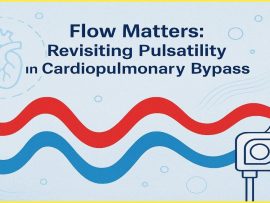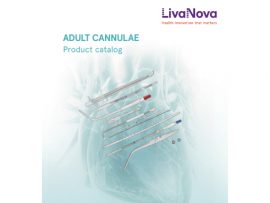Abstract Background: The use of VA extracorporeal membrane oxygenation (ECMO) for cardiac recovery is widely adopted, with extensive publications on assessing readiness to wean from VA ECMO. Techniques to reduce..
Read MoreAbstract Background Active mechanical circulatory support (MCS) is associated with high complication rates. Reducing device-related complications may improve outcomes in patients with infarct-related cardiogenic shock (AMI-CS). This study aims to..
Read MoreAbstract Rotary Blood Pump (RBP) is a commonly used ventricular assist device. However, the constant speed operation of the blood pump leads to a reduction of blood flow pulsatility, which..
Read MoreIntroduction The heart is nature’s pulsatile pump, delivering rhythmic surges of blood critical not only for oxygen transport but also for maintaining vascular health. Cardiopulmonary bypass, a lifesaving intervention, often..
Read MoreAbstract Assessment of cerebral autoregulation is challenging under different hemodynamic conditions during cardiac surgery and must be rapidly calculated in order to optimize mean arterial pressure (MAP). Whether systemic flow..
Read MoreIntroduction Extracorporeal circulation (ECC), used in cardiopulmonary bypass (CPB) and extracorporeal membrane oxygenation (ECMO), serves as a temporary replacement for the heart and lungs. It maintains tissue perfusion and gas..
Read MoreAbstract A 70-year-old patient with idiopathic dilated cardiomyopathy underwent implantation of a HeartMate III left ventricular assist device (LVAD) at INTERMACS IV. Postoperatively, right ventricular (RV) failure was managed with..
Read MoreAbstract The aphorism “Primum non nocere” underscores the responsibility of healthcare professionals to prioritize patient safety. Perfusionists, experts in extracorporeal circulation, play a pivotal role in maintaining cardiac function during..
Read MoreAbstract Background This study examines the role of extracorporeal life support flow in the development of acute kidney injury in cardiogenic shock. Methods We performed a retrospective analysis of 465..
Read MoreAbstract Background The most common complication of thoracic aortic disease with shaggy aorta is cerebral infarction. We have performed “low-flow perfusion” as a method of extracorporeal circulation to prevent cerebral..
Read MoreAbstract Objective: To define a reference chart comparing pressure drop vs. flow generated by a set of arterial cannulae currently utilized in cardiopulmonary bypass conditions in pediatric surgery. Methods: Cannulae from two..
Read MoreAbstract Extracorporeal membrane oxygenation is a life-saving support therapy in the case of cardiopulmonary refractory failure. Its use is associated to complications due to the presence of artificial surfaces and..
Read MoreAbstract OBJECTIVE: Measuring fluid responsiveness is important in the management of critically ill patients, with a 10–15% change in cardiac output typically being used to indicate “fluid responsiveness.” Ideally, these changes would..
Read MoreAbstract Cardiopulmonary bypass (CPB) is a common procedure carried out to provide a fluid free and motionless work field at the time of cardiac surgical procedures. To achieve CPB, cannulation..
Read MoreAbstract Aims Venoarterial extracorporeal membrane oxygenation (VA-ECMO) is currently one of the most used devices in refractory cardiogenic shock. However, there is a lack of evidence on how to set..
Read MoreAbstract Venoarterial extracorporeal membrane oxygenation (VA ECMO) is used to provide cardiopulmonary support in cardiogenic shock; however, high extracorporeal flow may increase left ventricular (LV) afterload leading to LV distention..
Read MoreIntroduction This study aimed to test a computer-driven cardiovascular model for the evaluation of the visceral flow during intra-aortic balloon pump (IABP) assistance. Methods The model includes a systemic and..
Read More















